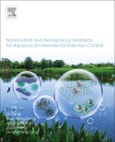Nanohybrid and Nanoporous Materials for Aqueous Environmental Pollution Control gives a comprehensive treatment of fabrication methods and their application in environmental remediation, including adsorption, catalysis and signal transfer in pollutant detection. The design, fabrication and application of nanohybrid and nanoporous materials for environmental pollution control are described in detail, along with discussions on their synthesis, characterization, and applications in different aspects of pollutant treatment. Chapters introduce the design and synthesis of magnetic nanohybrid materials, advanced oxide process-photocatalytic degradation of environmental pollutants based on nanomaterials, and nanohybrids of iron based materials for reduction and oxidation of aqueous recalcitrant pollutant.
Finally, challenges and suggestions in the application of nanomaterials for environmental pollution control are discussed, as is an analysis of the future perspective of nanomaterials for environmental application.
Please Note: This is an On Demand product, delivery may take up to 11 working days after payment has been received.
Table of Contents
1. Magnetic nanohybrid materials for water pollutant removal2. Mesoporous carbon based composites for removal of recalcitrant pollutants from water
3. Mesoporous carbon based composites for adsorption of heavy metals
4. Mesoporous carbon based enzyme biocatalyst for organic pollutant degradation
5. Nanohybrid photocatalysts for heavy metal pollution control
6. Nanohybrid photocatalysts for recalcitrant organic pollutant degradation
7. Iron based nanohybrids for aqueous recalcitrant pollutant treatment
8. Nanohybrid materials based biosensors for heavy metal detection
9. Nanoporous materials based sensors for organic pollutant detection
10. Summary remarks and future perspective








